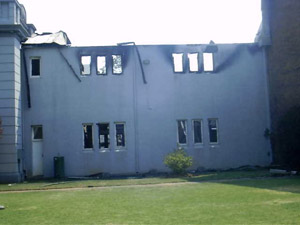
The struggling Jewish community of Bulawayo in Zimbabwe is
seeking to put the pieces together following the shocking
burning down of their historic shul this past Shabbos
Shuva. The shul caught fire from a burning hedge
outside, and foul play is not suspected.
Through the heroism of two congregants, Rodney Lepar and
Raymond Roth, who ignored protests from firemen and plunged
into the burning building, the six sifrei Torah
together with the nearly 300-year-old curtain for the
Aron Kodesh were rescued, but it was not possible to
save the siddurim and seforim. Distraught
members of the community could only stand by and watch as
their beloved place of worship was inexorably gutted.
Perhaps the most heartrending sight was the 104-year-old Rev.
Laizer Abrahamson who, after the flames had been doused, was
left standing and staring at the ruined shell of the building
in which he had officiated at so many sacred services,
holding his walking stick in one hand while wiping away tears
with the other. He asked what he would be buried in when the
time came since both his talleisim had been consumed
by the flames.
Ironically, the Bulawayo Hebrew Congregation was founded the
day after Tisha B'Av in August, 1894, the day the burning
down of the Beis Hamikdash was completed.
The manner in which the sifrei Torah were rescued has
been seen by many people as a neis. Both Mr. Lepar and
Mr. Roth claimed to have seen a separate sefer Torah
through the window of the burning building, taking this
as a sign min haShomayim that they should go to their
rescue. In fact, neither could have seen anything since all
the sifrei Torah were locked away behind a steel
curtain, which the two men had to wrench aside in order to
access their contents.
Fewer than 200 Jews, mainly elderly people, now live in
Bulawayo, down from a high of around 3000 in the 1960s. There
has been a Jewish presence in what is today the second
largest city in Zimbabwe from the time of its founding, with
the first services being held in a canvas tent a year after
the arrival of the first white settlers in the area. The
sorely depleted community prides itself on the fact that it
has managed to muster a minyan at least once every day
for over a hundred years.
The congregation continues to function, with services taking
place in temporary premises. Sadly, given the perilous
financial position and depleted numbers of the Jewish
community in a country whose economy has been in free fall
for years, it is probably highly unlikely that any new
shul building will emerge from the ashes.




